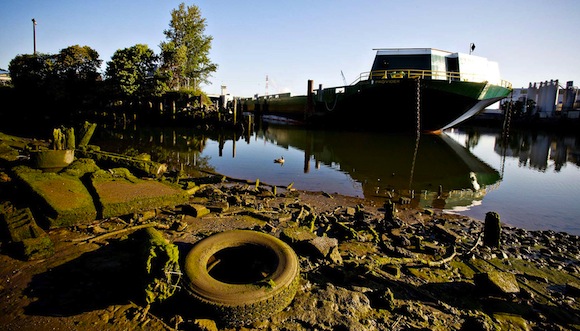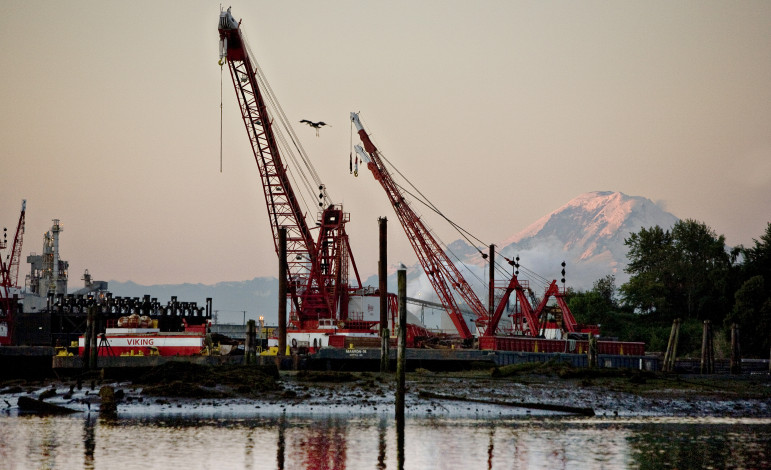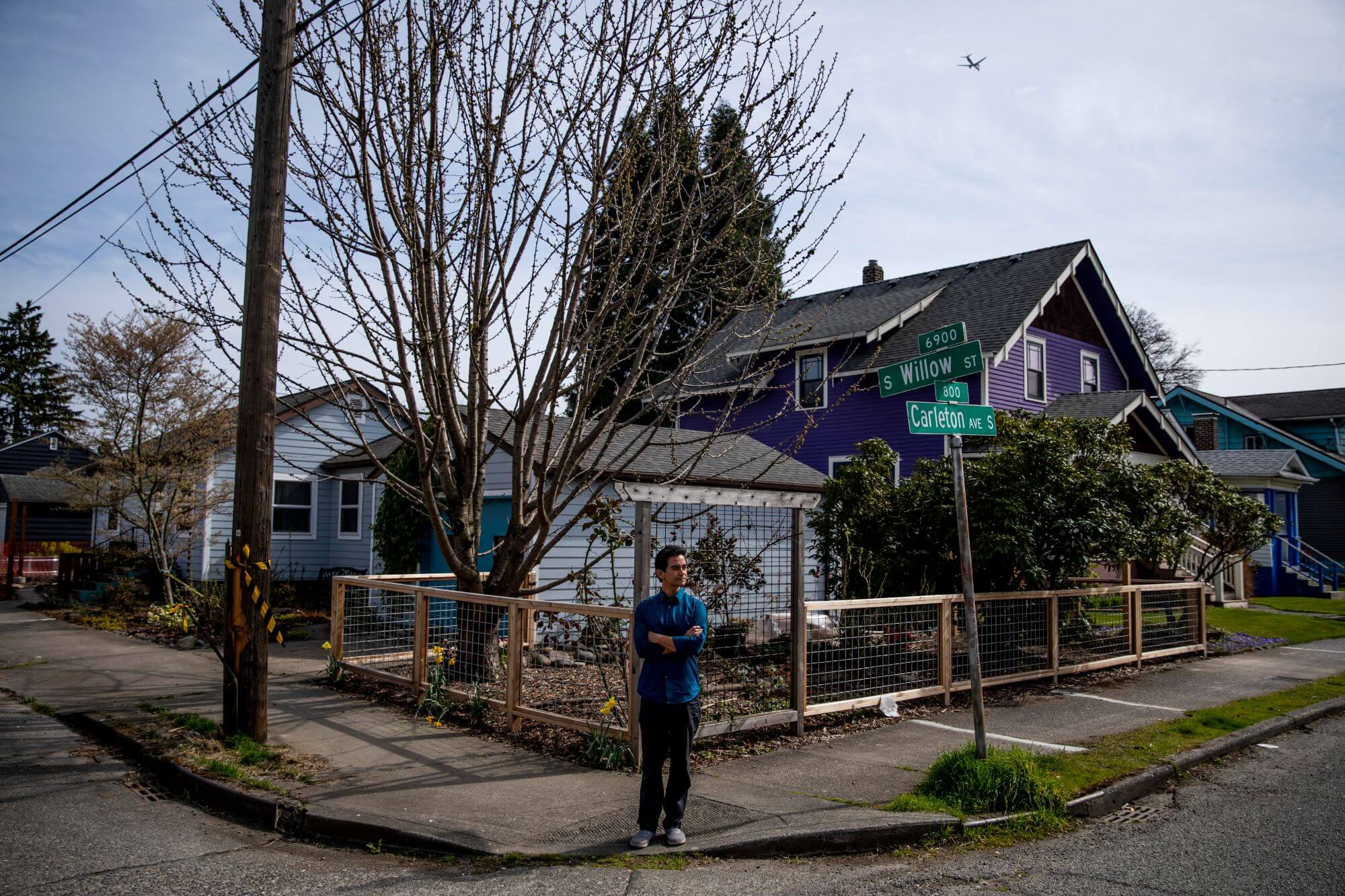With strong mandates stripped out, landmark environmental justice legislation approaches passage
After decades of inaction and false starts, Washington lawmakers are on the verge of taking a first, tentative step toward addressing environmental racism in the state.
Now, they have to hope state regulators will follow along.
The legislation, known as the HEAL Act, would push state agencies to decisively address environmental inequities that disproportionately hurt Black, Latino and Asian residents. The bill would prod — but not exactly require — government agencies to meet the needs of communities of color that the state has failed to protect from pollution.
At its core, the HEAL Act will enable the people harmed when environmental protections fall short to shape state decisions and actions, said David Mendoza, who co-chaired a state task force examining racial environmental health disparities.
“What’s clear to a growing number of people is that, even though government is supposed to serve all the community, that’s not the case,” said Mendoza, a longtime environmental policy worker now with The Nature Conservancy.
As it stands, the legislation creates a framework with two goals — ensuring that decisions by state agencies improve the lives of those most often harmed by pollution, and requiring that regulators listen to those communities and support them.
While boosters remain enthusiastic about Senate Bill 5141, the legislation has been weakened considerably as it passed the Senate and began moving through the House.
For instance, the bill originally gave an appointed council the authority to force agencies to make good on pledges of inclusion and equity. The council’s role now has been made advisory. And hard requirements directing state funds toward areas most harmed by pollution have been removed.
Additionally, the bill now gives agency heads the power to waive environmental justice reviews in certain circumstances.
‘Social justice begins with steps like these’
While the bill’s eventual impact remains uncertain, the HEAL Act’s passage appears assured as it retains broad support from Democrats, who control the Legislature and the governor’s mansion.
By any measure, it has been a long time coming.
Olympia began to analyze environmental racism in 1993, with a study written into the state budget by then-Sen. Rosa Franklin, the first Black woman to serve in the state Senate. That study was a step down a winding road toward an environmental justice task force, convened by the Governor’s Office in 2019, which issued a report in late 2020 that serves as the foundation for the HEAL Act.
A map drawn up for the state Department of Health and released two years ago was a pivotal point. The map of environmental health disparities illustrated what had long been known: Pollution in Washington has been concentrated in areas that are most often homes to people of color.
Dark red bands marking areas with the most harmful pollution trace Interstate 5 through Seattle and Tacoma, and saturate much of the Tri-Cities, Yakima and Spokane. Around Puget Sound particularly, those pollution rates track tightly with levels of racial diversity.
Black Washingtonians are 10 times more likely to reside in highly polluted areas than would be expected if the burdens of pollution were equitably shared, according to the 2020 task force report. Whites, who account for nearly 70% of Washington’s population, are a minority in the state’s most-polluted areas and account for 83% of the population in the state’s cleanest spots.
Life expectancy for residents in the state’s most-polluted communities was determined to be nearly six years shorter than for those in the least-polluted spaces. While that disparity can’t be attributed to pollution alone, advocates contend it shows that people under a range of pressures — poverty, racism and lack of economic opportunity among them — have been shunted into areas where environmental harms are acute.

The Duwamish River, Seattle’s only river, runs through some of the city’s most diverse neighborhoods. Pollution along the Duwamish was rampant for decades. The river’s polluted sediments are gradually being cleaned up under the federal Superfund program for toxic waste sites. (Photo: Paul Joseph Brown/InvestigateWest.)
Sen. Rebecca Saldaña, a Seattle Democrat and the legislation’s prime sponsor, credits the bill’s existence to activists and their supporters in the Legislature, which now is the most racially diverse in state history. She also noted that the coronavirus pandemic, its attendant wave of job losses and the resurgent racial justice movement have “laid bare many inequities” common in Washington state.
“The HEAL Act will be enormously consequential in ensuring that communities that have the highest environmental health burdens will be front and center in decisions about making cleanup investments, revising regulatory standards, adopting new policies, and other major actions,” Saldaña said by email.
The bill mandates that six state departments — Agriculture, Commerce, Ecology, Health, Natural Resources and Transportation — plus the Puget Sound Partnership, created to coordinate the environmental restoration of Puget Sound, examine the environmental justice ramifications of their actions. In their budgeting and discretionary spending, the departments are directed to emphasize work that reduces harm to communities hardest hit by pollution.
Supporters of the legislation expect state agencies will improve their efforts to gather input from racial and ethnic minority communities hurt by environmental pollution. As Mendoza describes it, that outreach could be as simple as rescheduling hearings so people who work during the day can attend them.
Mendoza envisions a cultural shift in state government so that concerns voiced by people living with pollution are taken more seriously and answered with state money.
Addressing the Legislature, Mike Gonzalez of the Franklin County Public Utility District highlighted the need for state funding as lower-income communities attempt to address environmental injustice while cutting greenhouse gas pollution.
Speaking in support of the bill, Gonzalez, communications director for the utility district, noted that racially diverse, lower-income communities like Pasco need financial assistance if they’re going to correct longstanding inequities.
“Social justice begins with steps like these,” Gonzalez said during a March 16 hearing on the bill. “Does it solve the problems? No. But at least we’re starting the conversations.”
Goals replace requirements
Since it was introduced in January, key provisions in the bill have been watered down to make many of its requirements optional.
The council would track several aspects of environmental health: illnesses and deaths caused by pollution; deterioration of individual ecosystems; and access to safe food, including fish.
While the initial version of the bill would have given the council true oversight authority, those provisions have been stripped out. The council’s role would be advisory, and neither the council nor the public at large would be provided new avenues for legal action.
The legislation does require that the council regularly report to the Legislature and Governor’s Office on the agencies’ activities related to environmental justice. Saldaña described those “progress reports” as a way to ensure agencies are making changes so the Legislature will be in a position within “the next three to five years to assess just how consequential this legislation has been.”
The advisory nature of the council, Saldaña said, will give agencies time to digest recommendations and make the changes needed “to ensure that communities and groups that historically have been marginalized [are] provided greater engagement, consideration and benefits.”
As passed March 25 by the House Environment & Energy Committee, the legislation establishes a goal that 40% of discretionary expenditures related to environmental health and restoration go to areas of greatest environmental inequity, as described by the map maintained by the Department of Health. Dropped from the bill was language requiring that “no less than 35% of investments that create environmental benefits” be directed to those communities.
The bill’s current incarnation also allows agency heads to exempt projects from environmental justice review if they find there is a pressing need to do so. It requires those reviews only on public projects valued at $5 million or more, when significant changes in agency rules or state law are considered, when a new funding program is launched, or when an existing program spends more than $25 million at once.
Costs unclear
The Legislature’s Republican minority has uniformly opposed the bill, and several leading trade groups have lobbied against it. Critics cast the legislation as an additional layer of bureaucracy that will impede economic growth without improving the lives of Washingtonians hurt by pollution.
Having spoken against the bill in the Legislature, Peter Godlewski, government affairs director for the Association of Washington Business, expressed concerns that environmental justice reviews would slow the permitting process for businesses.
It hasn’t been clear, Godlewski said, how extensive an analysis would be required under the law. That uncertainty could dissuade businesses from moving forward with new facilities, as they could not know at the onset whether the project will be hung up.
“We’re concerned that it might be difficult to site some projects,” Godlewski said.
Saldaña disputes the contention that the HEAL Act will significantly complicate permitting. For private-sector projects, environmental justice assessments will be rare — only the largest projects would require one — and minimal in scope compared to the broader permitting system.

Industrial activity along the Duwamish River in South Seattle has heavily polluted the river and, in some cases, nearby neighborhoods, which number among the most diverse in the city. The HEAL Act, which appears to be approaching enactment, would create a state advisory council to ensure that members of racially diverse communities can participate in policies affecting their environment. The proposed council’s power originally was stronger but has been weakened during the legislative process. (Photo: Paul Joseph Brown/InvestigateWest)
Additionally, a handful of Republican legislators have argued that state agencies aren’t being held accountable for having allowed environmental inequities to fester.
“None of us could oppose what is obvious there, that there are significant health risks in an environment where there isn’t accountability for any of the agencies,” Rep. Mary Dye, R-Pomeroy, said during a March 25 committee hearing.
State agencies have offered wildly varied cost estimates for compliance with the HEAL Act, but lawmakers contend they’re inaccurate to the extreme.
The Department of Natural Resources, for example, pegged the cost of an environmental justice assessment as equal to those of a detailed, science-heavy review required under the State Environmental Policy Act, and suggested the agency, which mostly manages state forests and other public lands, would have to add 25 employees to do the work. By contrast, the Department of Ecology and the Department of Health — agencies working far more intensely on environmental justice issues — each estimated they would need to add seven employees.
Saldaña said the bill’s supporters have been working with the departments, including Natural Resources, to clarify the legislation’s scope. She said she expects the cost estimates will be revised before the bill is put up for a House floor vote later this month.
Mendoza described the HEAL Act and other legislation addressing environmental equity as “steps on the path” away from a history that allowed pollution to be concentrated in communities that were cut out of political power.
Decisions made decades ago, choices colored by racism, are killing people today, he said. He believes the HEAL Act can start to correct that.
“I hope that we can see real impact in people’s lives,” Mendoza said. “Right now we see that life expectancy for folks who live in the most polluted places is years less. I want to see that change.”
Maybe it’s the pandemic. Maybe it’s last summer’s wave of racial justice protests. Maybe it’s that the Legislature, while still overwhelmingly white, is more racially diverse than ever.
Whatever the reason, Washington lawmakers are paying particular attention to environmental justice issues during the current legislative session. The flagship bill on the issue is the HEAL Act, which would direct state agencies to consider environmental inequities in their decisions. Here are some of the other bills addressing environmental justice issues:
Senate Bill 5126 and Senate Bill 5373: Two big (and competing) pieces of climate legislation — The Climate Commitment Act and Washington STRONG — would direct millions of dollars toward environmental restoration work in communities hardest hit by pollution. The exact amounts have been in flux, but the Climate Commitment Act would direct about 17.5% of the revenue derived from the cap-and-trade system it would create to Washington’s most polluted places. Washington STRONG, a carbon tax that remains stalled in the Legislature, includes larger supports.
House Bill 1099: This climate-oriented rewrite of state urban-planning rules would require that the state’s largest cities and counties consider the ramifications of planning decisions on already over-polluted neighborhoods. Local governments would be directed to “avoid creating or worsening environmental health disparities.”
Senate Bill 5345: Aimed at coordinating the disposal of industrial waste, the bill directs that highly polluted communities be spared any additional pollution when new industrial waste facilities are built.
House Bill 1216: This bill would revive an urban forestry program with an eye to building up tree canopy in cities where too few trees currently grow. Half of all spending through the program would go to communities currently living with an unfair share of Washington’s pollution.
Feature image: David Mendoza on a residential street corner near Georgetown. Mendoza, who now works for The Nature Conservancy, co-chaired a state task force examining racial environmental health disparities and is advocating for the HEAL Act in the Washington Legislature. The bill would address some of those environmental inequities that disproportionately hit Black, Latino and Asian residents. He is pictured in a Seattle neighborhood heavily impacted by these environmental health disparities. (Photo: Dorothy Edwards/Crosscut)



